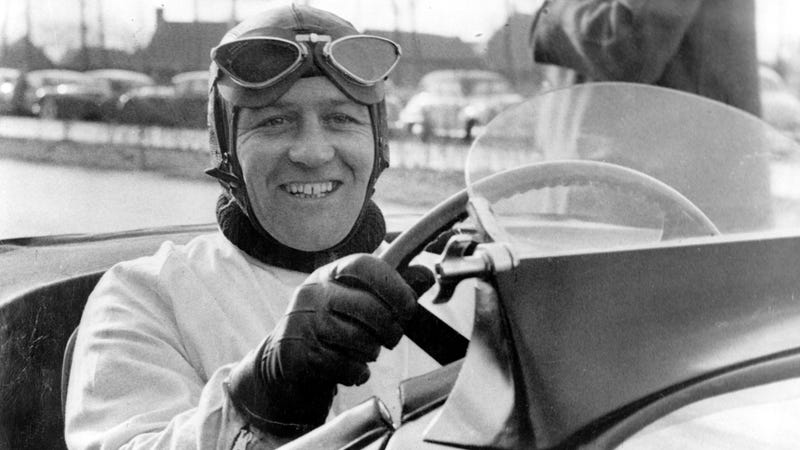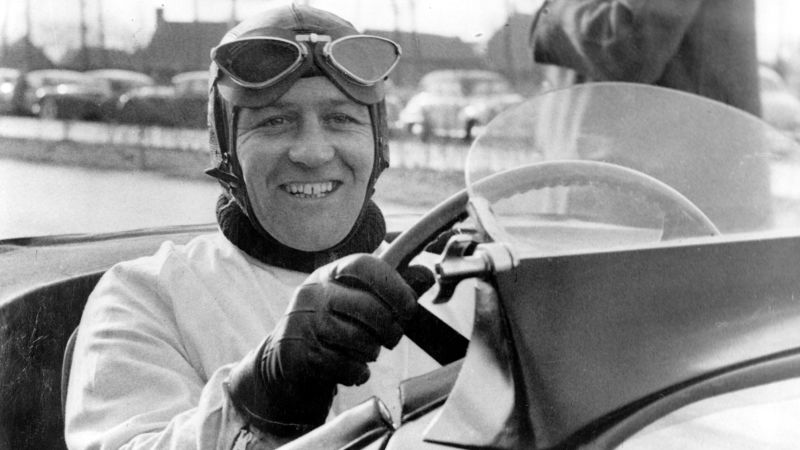
Had Norman Dewis not lost his father when he was 14, the world of cars may well have been a very different place. Disc brake development for road cars wouldn’t have gone the way it did, Jaguar’s C- and D-Type racers wouldn’t have established that marque’s legend, and some royal advisors may not have had a headache in 1957. Norman Dewis, the legendary Jaguar test driver who died Saturday at the age of 98, was one in a million.
You’d be forgiven for not being instantly familiar with his name, but you almost certainly know his work. He was Jaguar’s chief test driver from 1952 until 1985, and every car the firm turned out had to have his seal of approval.
Each car had to feel and, more importantly, go like a Jaguar should, and it was down to Norman to make that happen.
I’ve been lucky enough to spend a bit of time with him over the years and on each occasion he was sharp as a tack. He was always smiling, always had a story, and always gave as good as he got. He simply lit up any space he was in.
He’d developed legendary race cars, held records, had more crashes than you’d care to mention, competed in incredible races – and he was as humble, caring, and lovely as you’d hope a chap could be.
Advertisement
He had a life, and he sure as hell lived it.
Norman was all set to be an artist before his father died, but when that happened he had to step up and provide for the family. He went to work for early vehicle manufacturer Humber, then Armstrong-Siddley. It was at the latter that he, as an apprentice, was sent out to have a go at learning to drive and test cars. It was there that his natural aptitude for testing cars came forward.
He served as a tail gunner in a Bristol Blenheim during World War II, a truly dangerous assignment, before returning to work after the conflict at car firm Lea-Francis.
Advertisement

In 1952 he joined the company that would define his life’s work: Jaguar. It was there that he became something of a legend. Not only was he chief test driver and development engineer, but he was a racer, driving chaperone for royals and land speed record holder as well.
Oh, and he competed in the Mille Miglia to stress test a world first braking technology with Sir Stirling Moss at the helm. He was a badass.
Advertisement
His work with on disc brakes, a technology previously only available on airplanes, meant much secrecy and high-speed stress tests to see how long it would take for them to fail. Not only did Norman have to drive at triple figure speeds in a race car that wouldn’t likely look after him in a crash, but he had to wait for them to fail and see what would happen. And so he did, over and over again.
Initially they were developed to give Jaguar an advantage in racing, their final proof of concept test being the Mille Miglia in 1952. Dewis and Moss didn’t have the outright grunt of the Mercedes they were up against, but their braking power was superior, allowing them to overtake their competitors with ease.
They were set for a podium finish until they crashed out over 100 miles before the finish. From there they knew disc brakes worked, and not long after they were introduced as an option on the XK150—an option that pretty much everyone ticked.
Advertisement

Dewis was instrumental in getting the E-Type out in to the world as well. Not only had he developed it (it was supposed to be a racing replacement for the D-Type but it didn’t work out, so it became a road car), but he was summoned to drive 77RW, a British Racing Green convertible, from Jaguar’s base in Coventry to Geneva at a moment’s notice so the world’s press could see what it was all about.
The car had found so much praise that a single demo car wasn’t enough to sate the hungry press, and another was needed. At the end of a working day he was told he needed to be on a ferry that night to get the car there in time. The run from Jag’s base was frantic and he almost missed his ferry, the last of the night, and he would have done had a friendly guard not recognized the car and let him on board. At the other end he drove through Europe nonstop (with no highways) averaging 68mph to get the car there with moments to spare.
Advertisement
Not only that, he was then pressed to give press demonstrations for a full day immediately – no time for a nap, just get on and do it.
He was almost a fully fledged racing driver—you don’t do so many test runs in high performance cars without being, y’know, good at driving. As such he often served as a reserve driver. However, his job at the factory was deemed too important to risk by fielding him as a works driver.
I interviewed him about his career a few years ago and asked him about it. He could see the justification behind the decision to keep him away from professional racing, but you do get the impression that he’d have rather enjoyed it.
Advertisement
He competed at Le Mans once, in 1955, the fateful year where spectators and drivers were killed in a huge crash. He told me it would have been wrong for Jaguar to stop racing, and that when officials went to have a word with Mercedes they’d all vanished.

Dewis also had a few encounters with the British royal family. On one occasion in 1957, he was told to demonstrate the XKSS sports car to Prince Philip, and under no circumstances drive above 50 mph. Dewis asked the Royal how fast he wanted to go, and apparently he was cool as a cucumber when they hit 135 mph.
Advertisement
Naturally, when the prince asked for a go himself, Dewis couldn’t exactly say no. He recounted the story with glee, noting that he could see the frustration and terror of the gathered advisors as they pulled back in.
For a time, Dewis was a speed record holder. In Jabbeke, a stretch of road in Belgium, top speed tests were performed. During a top speed test for Motor magazine in 1952, Dewis clocked a C-Type at 145 mph in the rain. A year later he took a Mk VII saloon, a C-Type, and an XK120 over in order to grab the saloon, outright, and sports car top speed records. He did. The next year, his production sports car record was lost to Pegaso who had clocked 155 mph.
Sir William Lyons, the famed co-founder of Jaguar Cars, suggested he go back and return that company to its former glory. The standard XK120 was at its limits, but with modification it could go faster. With Jaguar’s engineers and designers, a special XK120 was put together. The passenger compartment was closed off, a Perspex bubble from a glider added to enclose Dewis inside a now-aerodynamically sound cabin, a headlamp was removed to feed air to the motor, tires pumped up, and more besides.
Advertisement
This wasn’t without its problems—the seat had to be removed to ensure Dewis could fit and the bubble would reach the body. He was sent in a car with no seat, an engine with some pretty jazzy modifications, told to run it harder than usually advised and try to go as fast as possible.
He hit 172.4 mph. In a bubble. With no seatbelt. The production sports car record was his once again.

Advertisement
Dewis was also the man who crashed the one-of-one XJ13 race car. He was driving the car for some filming to launch the V12 SIII E-Type. The XJ13 was running a damaged tyre that gave way, causing a huge crash. The car was nearly destroyed, yet Dewis, who had ducked in to the footwell, escaped without any major injuries.
After his formal retirement in 1985 he became an ambassador for Jaguar, appearing at events all over the world. He’d only very recently retired from that. He just never stopped doing things. His book, Norman Dewis of Jaguar: Developing the Legend, is a fascinating (and BIG) read.
“No matter what happens, you’ve got to come out of it successful,” he told me in our 2014 interview. He certainly did.
Advertisement














